By Kyler Moran, Preserve Stewardship Manager
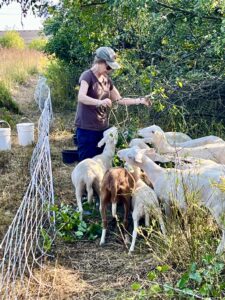 This year, the Legacy preserve stewardship team said “Welcome Baaaaaaack” to a flock of sheep from the Ypsilanti based organization Project Mow. This is our second year of working with Project Mow on a prescribed grazing project, where sheep are moved into temporary pens at Lloyd and Mabel Johnson Preserve to chew down invasive species.
This year, the Legacy preserve stewardship team said “Welcome Baaaaaaack” to a flock of sheep from the Ypsilanti based organization Project Mow. This is our second year of working with Project Mow on a prescribed grazing project, where sheep are moved into temporary pens at Lloyd and Mabel Johnson Preserve to chew down invasive species.
We expanded on the project this year, bringing the sheep out for two weeks rather than one like we did in 2023. Our initial plan was to bring the sheep out to the same plot twice in one growing season, so that they could chew down all of the available growth and then return after a few months to eat the resulting re-sprouts. However, the flock’s appetite out-performed our expectations, eating so much during their first visit that there was no significant vegetation for them to eat when they returned. As a result, we stationed them in two separate areas within the preserve this year.
During their first visit in July, the sheep returned to the same plot as they grazed in 2023. We were surprised to find that many of the sheep remembered the way into the fenced area at Johnson. To our delight, they hopped off the trailer, meandered down the path, scooted right into the pen, and immediately started eating the autumn olive.
When the sheep came out for their second visit in September, they stopped momentarily to check on their previous work location before following Project Mow’s head shepherd Yuko Frazier into their new temporary pen.
“Collaborating with Legacy Land Conservancy and contributing to something bigger than Project Mow has been special for many reasons,” Frazier said. “We’re thrilled to be an innovative part of land conservation management, and we’re grateful for the opportunity to share about the benefits of grazing and sheep care with the community.”
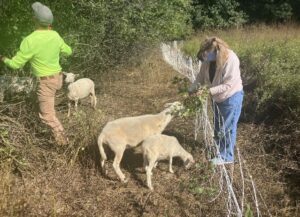
Legacy Eco-Steward Chuck Sawicki loves to cut back invasive buckthorn, and his wife loves to hand feed the vegetation he cuts to the sheep. We think they make quite a pair!
Our prescribed grazing project relies not only on local partners like Project Mow, but many volunteers as well, for whom we are very thankful! At the start of each “sheep week”, volunteers join Legacy staff to set up temporary fencing, move the flock into their pen, and attend a workshop led by Project Mow on basic animal husbandry and sheep care. While the sheep are at Johnson, volunteers visit daily to check on the sheep, ensuring they have adequate food and water.
Volunteers are also tasked with counting the sheep, to ensure that there are no escapees between visits. We are happy to report that no volunteers fell asleep while counting sheep, although the dulcet tones of their frequent bleating can be quite relaxing. Some volunteers go the extra mile, trimming invasive vegetation from above the height that sheep can reach so that they have extra food to eat.
The recent success of our prescribed grazing project has us excited about its potential beyond just invasive species management impact. At a peer gathering this fall, we learned there is another positive benefit of hungry sheep that could be incorporated into a more robust prescribed grazing program within our long-term prairie management goals.
In September, several stewardship team members attended a “Stewards of the Land” meeting with other land managers from Michigan land trusts. In addition to the remarkable experience of fellowship attained from spending time with like-minded peers discussing the successes and challenges in land stewardship work, Legacy staff learned valuable new information regarding the use of prescribed grazing for multi-dimensional, positive impact in the broader prairie management framework.
Michigan prairies have long been managed to produce habitat for a variety of grassland birds. However, results from a study completed on Southwest Michigan Land Conservancy (SWMLC) properties that were shared at the meeting, demonstrated that many restored prairies–like the prairie at Johnson Preserve–do not provide enough variation in vegetation structure for prairie bird species.
Grassland vegetation structure can be summarized as the height, density, and type of vegetation found within prairies. Some prairie birds, like the Eastern Meadowlark, prefer grassland habitat at a medium height and mostly composed of grasses. While the Horned Lark prefers their vegetation at a shorter height and more sporadic.
Currently, we utilize prescribed fire in the prairie of Johnson Preserve as a way to propagate the native fire tolerant plant species and eradicate the fire intolerant invasive species. Another outcome is it also provides variation in the structure of the vegetation that the SWMLC study noted is vital to supply critical habitat for additional grassland birds.
Additionally, we know that prescribed grazing–like prescribed fire–provides variation in vegetation structure. And as a result of the research conducted by SWMLC, we may have a new goal for our hungry sheep: to not only remove invasive species, but to improve the habitat for nature bird species as well! Thankfully, we have a ravenous herd of Project Mow sheep ready to eat. We’re grateful for our expanded partnership in 2024, and eagerly anticipate future opportunities to work together as we integrate more applications for sheep grazing into our innovative land management toolkit.

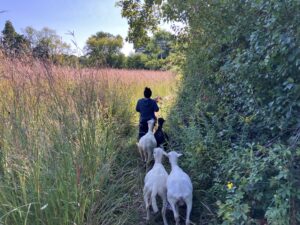
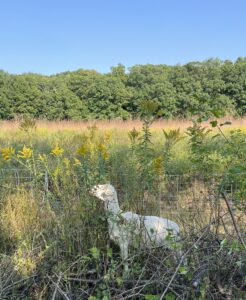
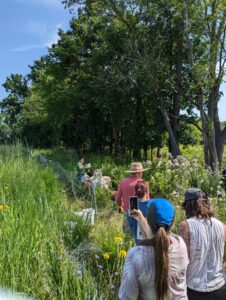
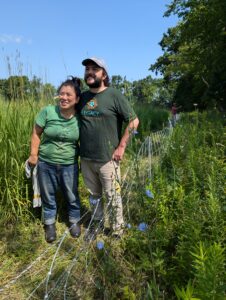
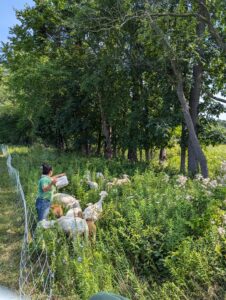
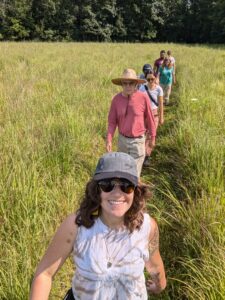
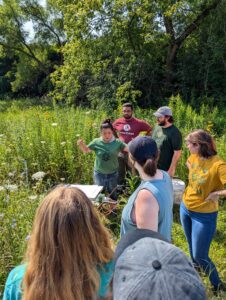
 RSS Feed
RSS Feed